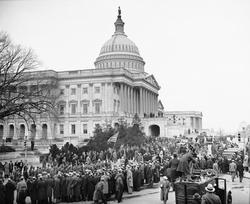Organizing the unemployed
 The federal jobs numbers released earlier this month showed that a whopping 14 million Americans are unemployed, with 6.8 million out of work now for more than 27 weeks.
The federal jobs numbers released earlier this month showed that a whopping 14 million Americans are unemployed, with 6.8 million out of work now for more than 27 weeks.The unemployment crisis has led to growing calls for the labor movement to take action to help the jobless -- by organizing them.
"We need the AFL-CIO, we need central labor councils that bring together different members to pool their resources and start organizing the unemployed," Bill Fletcher Jr. of the Center for Labor Renewal recently said in an interview with GRITtv.
The idea of organizing the jobless is not new: In 1894, populist politician Jacob Coxey of Ohio led unemployed workers in a protest march on Washington that came to be known as "Coxey's Army." The first significant protest march ever held in the nation's capital, it took place during the second year of a four-year economic depression that at the time was the worst the country had ever experienced. The marchers called on the government to create jobs through public works.
Later, during the Great Depression, militant left-wing labor organizations like the Workers Alliance, the Unemployed Workers' Councils and the Unemployed Citizens' League mobilized out-of-work Americans to pressure state and local governments for jobs and benefits. According to one historical account:
In cities like New York, Chicago, and Detroit, the Unemployed Councils made an immediate impact, staging large attention-getting demonstrations in the winter and spring of 1930 and in subsequent years building neighborhood based Councils that fought for public assistance and rallied neighbors to conduct rent strikes and resist evictions.And in 1932, a Roman Catholic priest from Pittsburgh named James Renshaw Cox led a march of 25,000 unemployed Pennsylvanians on Washington, calling on Congress to launch a public works program and increase the inheritance tax to 70%. The unprecedented mass demonstration -- dubbed "Cox's Army" (in photo above) -- spurred the founding of the Jobless Party and Cox's run for the presidency, though he eventually dropped out and gave his support to Democrat Franklin Delano Roosevelt.
Those grassroots organizing efforts helped build political support for helping the unemployed, eventually culminating in President Roosevelt's New Deal.
Today, with the Great Recession dragging on, there are efforts underway once again to organize the jobless.
Earlier this year, the International Association of Machinists and Aerospace Workers launched the Ur Union of the Unemployed, or UCubed. Unemployed and underemployed workers can sign up at UCubed's website -- www.unionofunemployed.com -- and are then organized by ZIP code to advocate for legislation to help the jobless.
"We're trying to connect unemployed people with one another to eliminate the sense of isolation that comes with being unemployed," an IAM spokesman told In These Times, "and to give people the means to be activists."
In Indiana, the Unemployed and Anxiously Employed Workers Initiative (UAEWI) was formed in response to the 2008 financial crisis. It's been involved in efforts to give unemployed workers a greater voice in shaping job retraining programs and was part of a successful effort to prevent cuts in unemployment insurance benefits.
Meanwhile, organizing is underway for an Oct. 2 mass demonstration in Washington calling for more government job creation. Among the groups involved in the One Nation Working Together march are the AFL-CIO, SEIU and NAACP.
Fletcher says marching on Washington is the right thing to do -- but he questions whether it's enough.
"What happens on Aug. 2? What happens on Sept. 2?" he asked. "Why aren't we talking about more localized actions where people are raising hell?"
(Photo of Cox's Army from from ExplorePAhistory.com.)
Tags
Sue Sturgis
Sue is the former editorial director of Facing South and the Institute for Southern Studies.
